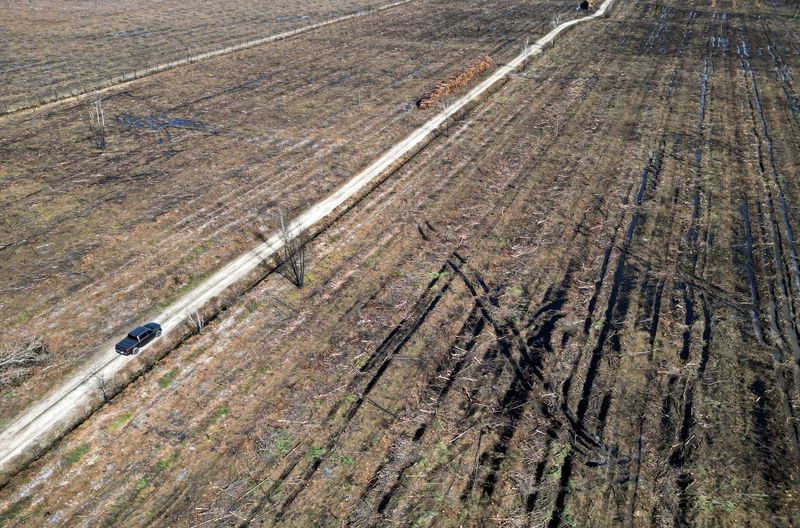By Juliette Jabkhiro and Stephane Mahe
HOSTENS, France (Reuters) - As France frets about an extended drought and prospects for more wildfires in another long summer, one blaze that erupted eight months ago in the southwest of the country still smoulders away underground.
Columns of white, acrid smoke rise from a forest floor outside the town of Hostens in the Gironde region, south of Bordeaux. The smell of burning tyres is caused by the brown coal in the area's peaty soil which is fuelling the fire underground.
"It's been burning since mid-July," said Guillaume Carnir, who works for France’s National Forest Agency (ONF). "To this date, we don't have a clear answer as to how to stop it."
The blaze at Hostens is a remnant of huge wildfires that ravaged southern Europe last summer when the worst drought on record was compounded by successive heatwaves which scientists say are consistent with climate change.
The Gironde region was particularly badly hit with 20,000 hectares of forest destroyed, and the risk of renewed fires is a great concern.
"All the greenery will come back in the spring, which will be flammable, so we have to make sure new fires can't start from these hot spots," Carnir said.
Pascale Got, a local official in charge of environmental protection, said that the fire at Hostens was under constant surveillance from drones measuring heat levels.
When it comes to wildfires risk, she said that prevention was crucial, as well as swift intervention when a fire first starts, which is easier to do from above.
"It is obvious that we need an urgent answer from the government on air assets," said Got.
The interior ministry said measures for fighting forest fires across France will be presented in the coming weeks.
An unusually dry winter across parts of the south of the European continent has reduced moisture in the soil and raised fears of a repeat of 2022, when 785,000 hectares were destroyed in Europe - more than double the annual average for the past 16 years, according to European Commission (EC) statistics.
Governments are thus working out how to make forests and woodlands more resilient to climate change with better scrub clearance, more hardwood trees that burn less easily and other steps to prevent the region becoming an inferno every year.
The risk from failure to act is collapsing soils, falling trees and the prospect of an endless cycle of increasingly uncontrollable fires that have not only devastated natural habitats but also destroyed homes and businesses.
Spain's first major wildfire of the year raged in the eastern Valencia region on Friday, destroying more than 3,000 hectares of forest and forcing 1,500 residents to abandon their homes, authorities said.
LUNAR LANDSCAPE
In Gironde, the wildfires that surrounded the town of Origne and displaced its inhabitants for two weeks last July are long extinguished. Firefighters managed to save all but one house, yet some scars remain.
"It's no longer the village I knew: there were woods, we could hike, it was wonderful," said Bernard Morlot, 79, who told Reuters he was thinking of moving away. "Now, it's the desert. It looks like the moon, it's dreadful."
Mayor Vincent Dedieu, 46, could not hide his sadness while looking at the wide empty land punctuated with piles of cut trees right outside the village.
"It will take at least 15 years to get back to a normal landscape," he said.
Dedieu added that he felt powerless and abandoned by authorities since the disaster: "We need to rebuild our roads and our pathways," he said. "It's going to be exceptionally costly, and so far we have zero."
From officials to wood workers, everyone agreed that clear pathways and firebreaks in forests are key to slowing down wildfires.
"The better the forest is looked after, the lower the fire stays," said Pierre Berges, 53, a private forest manager at local business Planfor.
For months now, Berges has been busy salvaging what he could from forests ravaged by wildfires. Below the charred bark of burnt trees, some wood is still in good condition and businesses like Planfor have been converting it into lumber, timber and fuel.
FOREST OF THE FUTURE?
When it comes to reforesting, burned patches will only be replanted next year. Some experts suggest that diversifying varieties of trees would make the forest more resilient.
But in private parcels, the economical incentive is to plant pine, that will rapidly grow into marketable wood.
"The maritime pine is a champion in all categories in terms of wood production, and even adaptation to the environment we have, with the strong variations in drought, the very draining soils," explained ONF agent Carnir.
But he said that shouldn't stop forest actors from bringing in a diversity that will help protect the forest from parasites and risks of fire spreading.
For the past few years, there has been a push for planting more hardwood trees, such as oak or birch. Jean-Marc Bonedeau, head of Planfor nursery, told Reuters over the phone that he has seen a drop of "classic" forest varieties in orders, not in volume but in proportion:

"Maritime pine used to make 70% of our production four or five years ago, now it's only 45%," Bonedeau said.
But finding seeds might become a challenge. "Climate change impacts the tree's ability to bear fruit," Bonedeau said.